20 notable remote work statistics in 2025

While remote work is not a new concept to everyone, the COVID-19 pandemic forced its acceleration globally.
Now with the world reopening, some businesses still find difficulty in balancing work options for their employees. There is still a mindset that remote work is a “fad” that will simply go away once the pandemic is over.
But will this be the case? These remote work statistics and studies [1] say otherwise.
The status of remote work in 2025
Remote work is here to stay, and experts are confident about it. Yet, some business owners and executives still contest the idea of having employees in the office.
The onset of the Great Resignation and the still-ongoing pandemic has strengthened the need for businesses to work remotely. Not to mention that many have realized its benefits to their companies and employee well-being.
Despite their resistance in the past, JPMorgan Chase and Goldman Sachs have finally caved into letting their employees work remotely.
JPMorgan Chase reportedly allowed some employees to go to the office two times a week. Meanwhile, Goldman Sachs only expects workers whose jobs are not applicable for remote work to come to the office – around half of its workforce.
While it seems that most companies are now practicing remote work at their offices, a new “deflector” rose against it: Elon Musk. The Tesla boss recently ordered its staff to return to the office full-time, citing that in-person collaboration was “critical to the firm’s success.”
The continuous adaptation and deflection still show that business owners and executives themselves still debate its effectiveness.

Notable remote work statistics
As remote work continues to be the “new normal” in most businesses, several trends continue to arise that prove the different sides of it.
It’s natural for businesses to get still conflicted about when and where to start remote working, even in the new normal. For starters, here are key remote work statistics in 2023 that can help form their decisions.
General remote work
Almost everyone wants (and would recommend) to work remotely…
Buffer’s 2022 State of Remote Work interviewed more than 2,000 people in 16 different countries on their views on remote work. This survey showed an overwhelming yet unsurprising result.
Out of 2,118 employees surveyed, 97% of them want to stay working remotely for “at least some of the time.” The same percentage also recommends remote work to their peers.
… while some still prefer working in the office.

A report by the think tank Pew Research revealed that some workers still prefer working in the office despite having roles applicable to remote work.
According to the report, six in 10 employees with remote work functions prefer working in the office. The same percentage cited productivity as their reason. Only 21% cited not having enough resources at home, while their supervisors pressured fewer (9%).
Geography affects the likeliness of remote work.
Aside from the functions and the industry the workers are in, geography also plays a part in the general likeliness to work remotely.
High-income, high-density cities saw more than twice the share of remote workers in the US alone compared to their less-dense counterparts.
Accessibility is one of the reasons for this. Remote work requires employees to have a strong internet connection, laptops, and access to online collaboration tools.
Some companies that allow remote work prefer having their employees in cities or nearby areas where accessibility is easier.
Remote work also affects real estate.
Despite the accessibility that cities provide, most employees would still prefer or think about moving if they have a permanent remote work option. Some of the main reasons for this include lower cost of living (45%) and better quality of life (56%).
This trend brings an impact on real estate everywhere, especially in big cities. As more employees move away to live in low-cost areas, cities lose occupants in residential properties, with some even left unoccupied for a long time.
A portion of high-paying jobs apply to remote work.
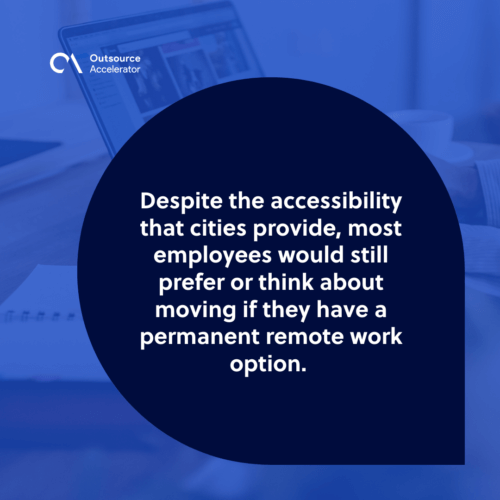
Ladders, Inc., an authority in high-paying jobs, found out that remote opportunities account for at least 15% of all high-paying jobs in the US. It is said that there are more than 30,000 high-paying jobs in North America.
This trend goes to show that remote work is here to stay, making most jobs available to talents worldwide.
Remote work benefits
Remote work extends its benefits to all aspects – from the company down to its employees and even the environment. Here are some of the statistics that say so.
Attracting and retaining more employees
The pandemic made employees realize that they can work from anywhere and still function well. This is why most of them would quit should they be required to work in the office.
Remote work can be effective in retaining and attracting employees, as most studies imply. Surveys have revealed that even the majority of executives (90%) expect to render remote work, removing location as a prerequisite in hiring new employees.
Environment-friendly option
Remote work also has an impact on the environment, as shown by research during the pandemic.
In the UK, for instance, an average worker spends an average of 1 hour and 38 minutes on the road, much of it spent on a car. Working from home could reduce pollutant gas emissions on a single vehicle by at least 10%, especially when intensified by up to four days a week.
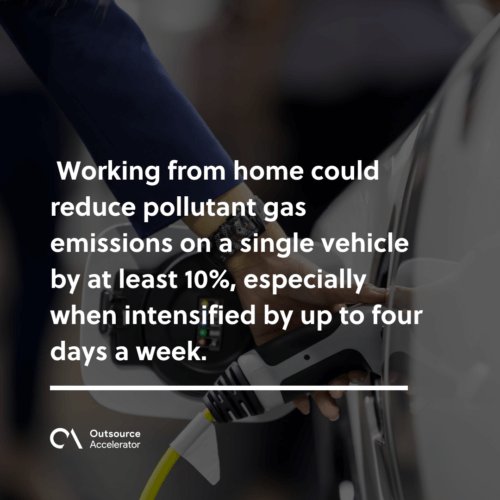
Decreased bureaucracy
A good number of employees think their employers have done their part in decreasing the bureaucracy and office politics.
A study by GitHub revealed that 61% of employees felt that their companies took action to improve inclusion, diversity, and belonging at work. However, while 64% believe that their company policies improved in these aspects, non-male respondents (61%) are less likely to believe this statement.
Better productivity
A FlexJobs survey revealed that employers experienced a boost or retention in productivity when working from home.
Studies by Global Workplace Analytics show that brands such as Best Buy and British Telecom have seen a 35-40% increase in the productivity of their workers. Other enterprises, meanwhile, experience higher (up to 60%) or the same productivity rate.
Another survey by Flexjobs revealed some of the top reasons employees feel more productive while on remote work. This includes the following.
- Fewer interruptions and more focus time
- More peaceful work environment
- Decreased office politics
Improved employee satisfaction
Lastly, companies see increased employee satisfaction and happiness when rendering remote work. According to Owl Labs, remote and hybrid employees are 22% happier with their work and stay longer with their employers.
Many remote workers account for better work-life balance as an advantage.
New (and existing) challenges in remote work
Yet, working remotely is not always advantageous. It poses risks and challenges for both employees and companies in different ways, as seen in the statistics below.
Cybersecurity issues
Issues on cybersecurity and data protection have been some of the top concerns in remote work.
A stunning reveal from cybersecurity firm Proofpoint showed increased insider threats and their costs during the pandemic. Most of these issues came from the “carelessness and negligence” of either the management or employees.
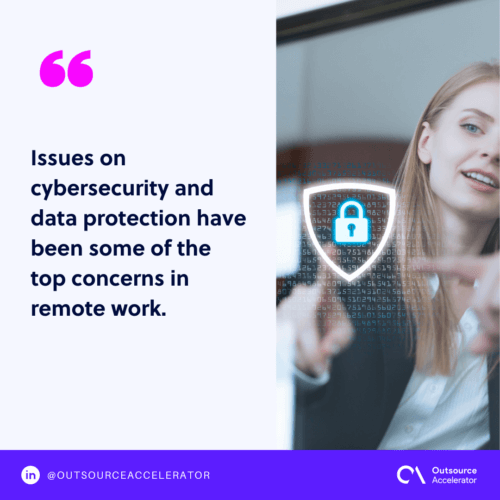
Burnouts and stressors
Remote work exposes employees to social and mental health risks, especially burnout.
A report from Jones Lang LaSalle (JLL) stated that only 36% of workers could maintain strong working and personal interactions with their peers at a distance. Delays in going back to the office have challenged interactions within teams.
Another report revealed that almost half of employees struggle to set boundaries when working from their homes. With their work and personal tasks getting mixed up, employees have higher chances of experiencing burnout and other stressors that come with it.
Challenges in employee training
While there are now tons of ways to train employees, companies still find challenges in training their employees.
HR platform TalentLMS surveyed 1,000 respondents regarding remote training and the opportunities for employee growth. Their results found that half of the respondents received training for the past 12 months (2020-2021), while half have not.
Having remote employees undergo at least online training can help them improve their productivity and the general quality of their training. However, in some cases, the employees are the ones that shoulder the costs of their upskilling efforts.
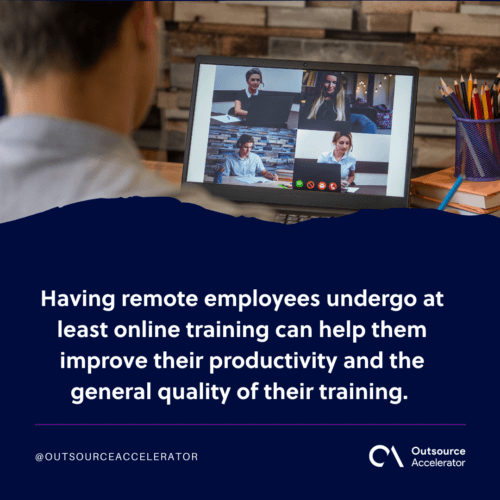
Issues on inclusion and fairness
With many companies going back to their offices, Gallup revealed inclusion and fairness issues arose within remote teams and their managers.
While many employees have reportedly grown closer to their team through video calls, remote working also exposed issues of fairness and differences. The 2020-2021 Gallup data showed that the more employees work from home, the less they receive feedback from their managers.
More online meetings affecting productivity
It is mentioned that remote work increased employee productivity. Unfortunately, it also increased the duration of online meetings and conferences.
Data from Timecamp revealed that employees spend more time in online meetings – around six to 12 hours per user. Excessive online meetings could also lead to burnout and other issues since most people only have to face screens most of the time.
Remote work in the future
Experts say that remote work is here to stay. More companies are now allowing remote work arrangements for eligible employees as part of improving their culture.
However, what it will actually look like would be uncertain for everyone. Here are some of the remote work trends to watch out for in the future.
Keeping up with employee demands – especially in remote work
For starters, companies have to learn to keep up with their employee demands. One of them includes rendering remote work when applicable and engaging them.
Gallup finds that great managers can help in reducing turnovers among organizations. They only have to communicate and engage with their employees in order to build trust among teams.
The changing concept of the ‘office’
Finding remote work to be successful within teams, fewer executives now want to revert their ways as it was pre-pandemic. However, the “office” won’t be gone as everyone knows it – only its concept and purpose will change.
A PwC survey reveals that only 13% of executives want to leave their offices for good. The majority, meanwhile, find the office crucial for collaboration and building relationships.
When asked how many days employees should be in the office for strong culture, most executives answered “at least three days.” Only 5% of them think teams don’t need to be in an office to maintain company culture.
Increasing remote opportunities through 2025
Ladders projected that remote work opportunities would maintain their rise through 2023. According to their research, opportunities for working remotely increased to 9% by end-2020 and now cover nearly 15% of all high-paying jobs in the US.
Hiring practices and changes in work arrangements, as implied by CEO Marc Cenedella, will continuously affect this trend.
More favor to hybrid working
Employees would at the least agree on a hybrid setup in the future than fully-remote work. According to statistics from McKinsey and Company, employees prefer a more flexible way of working with less anxiety and burnout.
47% of respondents felt a lack of vision post-pandemic from their companies, causing them to raise concerns and anxiety. This contributed to around 52% of employees aligning more with hybrid work.
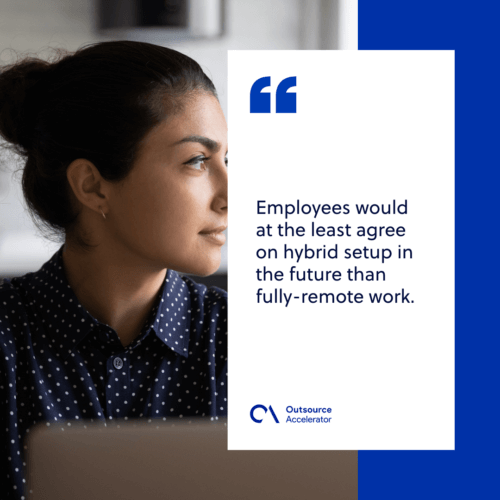
Autonomy in employees
In the end, the majority of companies still prefer deciding for their teams when rendering hybrid work. PayScale’s State of Remote Work stated that only around 15% of employers would allow their employees to decide how often they want to come to the office.
This somehow aligns with results from PwC since almost half (47%) of their respondents want to have their employees in the office around two to three days a week.
Getting into remote work through outsourcing
As technology advancements and mindsets evolve, remote work will surely increase and continue to benefit everyone worldwide.
The given remote work statistics above already say so. This is why companies should learn to adapt to this practice while setting boundaries on what forms will work and what won’t.
However, it is also understandable that employers will be hesitant with this setup at first. Aside from the resources, companies have to adjust even their entire business model to work around letting their teams work remotely.
Managing virtual teams when it’s your first time will be easier with a reliable partner to turn to. Outsourcing functions to a service provider is a good start for this.
Remote Employee, one of the Philippines’ leading providers of remote work opportunities, is a trusted firm to partner with for businesses just getting started with managing virtual employees.
By delegating services offshore, organizations can save money and resources on setting up, hiring, and training their teams. This includes the overhead costs of providing equipment and training their teams.
Outsourcing even opens its doors for small and medium businesses to hire a global workforce as enterprises can.
This is why companies worldwide are encouraged to delegate their services to countries such as the Philippines and India to not miss out on this opportunity.







 Independent
Independent




